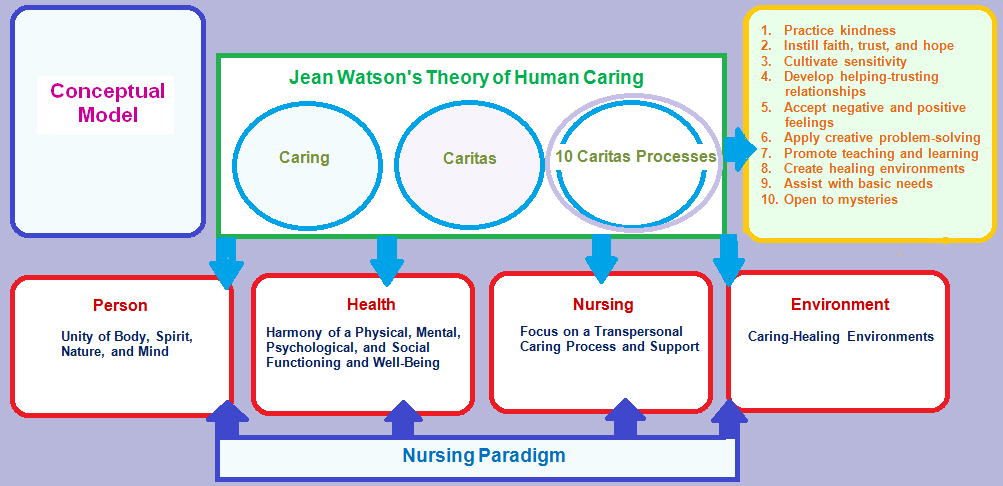Introduction
A visual representation of the concepts that guide a nurse’s practice is important to understand a person’s conceptual framework. The purpose of this paper is to present a conceptual model developed with reference to the personal philosophy of nursing. The synopsis that explains the components of the model is provided in the second part of the paper.
Conceptual Model
Figure 1 provides a conceptual model that represents how specific concepts of nursing can be interrelated and connected according to personal philosophy. The presented concepts can be viewed as the most important ones to guide personal practice. The model is based on Jean Watson’s Theory of Human Caring.

Synopsis
The conceptual model presented in Figure 1 demonstrates how the personal philosophy of nursing is based on understanding the key elements of the metaparadigm of nursing while interpreting them through the lenses of Watson’s Theory of Human Caring. From this point, the nursing paradigm, which includes person, health, nursing, and environment, is the base or foundation for this personal conceptual framework (Alligood, 2014). However, these key concepts are reconsidered from the perspective of Watson’s theory. Therefore, in this model, person, health, nursing, and environment are explained with reference to Watson’s theoretical assumptions and principles.
Specific factors that influence the conceptual model are patients’ needs for care and support from nurses. As a result, the focus is on building trusting relationships between nurses and patients, and this idea is supported by Watson’s theory (Ozan, 2015). Another important factor is a practice specialty because those patients who are observed in a trauma and emergency unit require much attention, care, and assistance from nurses (Alligood, 2014).
This model also demonstrates how the metaparadigm of nursing can influence a personal approach to caring and work with patients. Such concepts as a person, health, nursing, and environment remain to be the core of the nursing practice. Still, these ideas are reinterpreted with reference to the concepts promoted by Watson: caring, caritas, and ten caritas processes, which allow for building effective and trusting relationships with patients, and they are based on respecting patients’ needs and values (Pajnkihar, McKenna, Štiglic, & Vrbnjak, 2017). Therefore, the components of the metaparadigm are related to both the grounds of the nursing practice and Watson’s specific theory.
The conceptual model can be applied to practice at different levels of knowledge. For a novice nurse, it is possible to expect focusing on the paradigm of nursing and its components. When these basic elements are studied, and effective approaches to cooperating with patients are practiced, it is possible to refer to following the concepts of Watson’s theory and demonstrate caritas and caring with reference to the redefined elements of the paradigm.
Expert nurses are expected to work while following the principles of caring and building trusting and cooperative relationships with patients (Ozan, 2015). In addition, expert nurses should be able to apply ten caritas processes that are based on the idea of demonstrating support and care for patients while accepting and respecting their differences, needs, visions, values, and beliefs to achieve positive outcomes and contribute to developing a patient’s physical, emotional, and spiritual health.
Conclusion
The conceptual model created with the focus on the personal philosophy of nursing is presented as a visual and discussed in detail. The factors that could influence the development of the model are described. The relationship between the concepts, the metaparadigm of nursing, and different levels of practice are explained.
References
Alligood, M. R. (Ed.). (2014). Nursing theorists and their work (8th ed.). St. Louis, MO: Elsevier Health Sciences.
Ozan, Y. (2015). Implementation of Watson’s Theory of Human Caring: A case study. International Journal of Caring Sciences, 8(1), 25-32.
Pajnkihar, M., McKenna, H. P., Štiglic, G., & Vrbnjak, D. (2017). Fit for practice: Analysis and evaluation of Watson’s Theory of Human Caring. Nursing Science Quarterly, 30(3), 243-252.